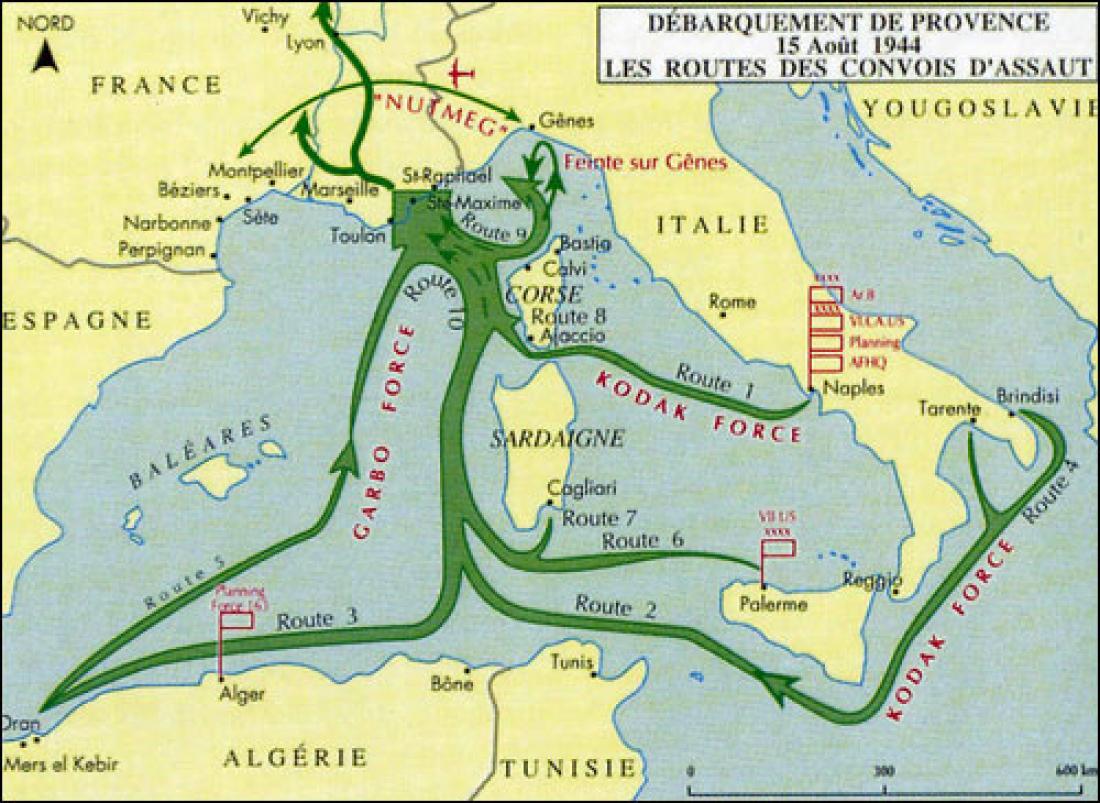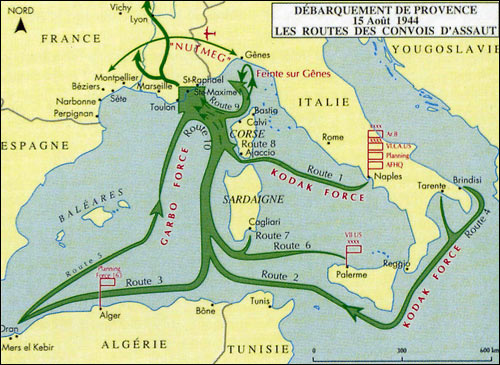Operation Anvil-Dragoon in detail

Operation ”Anvil-Dragoon” (code name for the landing in Provence) D Day: 15 August 1944
Account by General de Lattre de Tassigny (extracts)
”That day, three divisions of the 6th United States Army Group, backed up by our Africa Commandos and the Corsica naval group, were to land between Toulon and Nice in the region of Saint Tropez and Saint Raphael. Then, starting the next day, 16 August, the first echelon of the French Army was to land, passing to the left of the Americans and marching on Toulon and Marseille, the two centres of German resistance on the Mediterranean coast.
An unforgettable sight, from Taranto and Brindisi, from Ajaccio and Bastia, from Oran and Algiers, hundreds of vessels converged to form an Armada of more than 2,000 ships concentrated on the selected landing sites. On the 16th at 5.00 pm, land was in sight (...). One hour later, despite the German aviation's bombardments, the first elements landed and, under the protection of the convoy's air defences, the landings continued without interruption.
The operations plan did not call for the attack on Toulon to begin until two weeks after the landing, once the first two echelons of the French Army, with the necessary artillery and munitions, had landed.
Now, on 18 August (...) a decision had to be made. (...) Toulon was attacked immediately, in a charge, with whatever resources were available. Sixteen thousand fighters went into battle with thirty tanks and a few artillery batteries. On the other side, the Germans had some 25,000 soldiers and sailors, solidly entrenched in the powerful defences mounted with automatic weapons and two hundred and fifty canons of our largest military harbour (...).
For five days and five nights of fierce fighting, our troops struck at the enemy with increasingly violent blows at a constantly faster rate, finally forcing them to surrender. (...). On the 26th, we occupied the city of Toulon. The 27th at noon, Admiral Ruhfus, holding out on Saint Mandrier Peninsula with the canons of the 340th Navy unit, his staff and 2,500 elite soldiers unconditionally surrendered. But already on the 20th of August, seeing how the Battle of Toulon was evolving, I decided to undertake an action toward Marseille without delay. It was, in fact, a question of taking advantage of the success we had had and notably to keep the German Command from sending reinforcements from Marseille to Toulon. That is why the Moroccan Tabors headed out behind the 1st Armoured Division and elements of the 3rd Algerian Infantry Division, which was already on the Route des Maures headed for Aubagne.
Then, like a tidal wave, the manoeuvre began to swell around the great city of Marseille. The gates of the city were reached on the 22nd.
For three days already the national uprising - the holy insurgency - had broken out in the city, where the FFI had liberated streets by bravely pushing the enemy back into its strongholds.
On 23 August, the Algerians of the 3rd Algerian Infantry Division and the tanks of the 1st Armoured Division made a daring push all the way to the Vieux Port, joining hands with the Résistance. General de Monsabert whom I had put in charge of this second theatre of our Battle of Provence on the 21st, immediately set up his command post in the centre of Marseille. But the struggle continued (...).
The epilogue came on 28 August: the German General Schaeffer, commander of the fortified sector of Marseille, raised the white flag on Fort Saint Nicolas and surrendered with the rest of his troops. Thus, at the same time, Toulon, an essential objective in the Allied Armies' operations in the South of France, had been conquered in 6 days, and Marseille, for which the initial plans had called for an attack two months after the landing, had fallen in 8 days: the Battle of Provence was won more than 60 days ahead of schedule”.
Forces engaged in the Provence landing
1 - Land forces
1° General Patch's 7th US Army comprising the ”South-East France Expeditionary Force” for Operation Dragoon.
It included:
- the 6th US army group (General Truscott) with 3 divisions: the 3rd, 36th and 45th US Infantry Division;
- an Anglo-American airborne division.
2° The 1st French Army (General de Lattre de Tassigny) comprising:
- five infantry divisions;
- two armoured divisions;
- two Moroccan Tabors Groups (GTM);
- elements of the general reserves not assigned to divisions: a ”commando group” a ”shock battalion” of general reserve tank units and paratrooper units.
In all, there were 11 Allied divisions, including 2 armoured divisions and 1 paratrooper division, for 350,000 men, including 230,000 French troops.
2-Naval forces
The naval forces formed the ”Naval Western Task Force” and counted 2,120 vessels under the orders of American Admiral Hewitt; support forces were commanded by Rear Admiral Davidson.
1,250 warships:
5 battleships (including 1 French ship, ”La Lorraine”);
10 escort aircraft carriers (8 English, 2 Americans);
25 cruisers (including 8 French: ”Duguay-Trouin”, ”Emile-Bertin”, ”Georges-Leygues”, ”Gloire”, ”Montcalm” and three light cruisers);
109 torpedo boats and escort vessels (including five 1,500-tonne French torpedo boats and some fifteen small ships).
(For the first time since 1940, French vessels made up a large force with 34 ships organised in several divisions and squadrons. They were placed under the orders of Rear Admiral Lemonnier). 2,600 large transport ships and 1,270 landing craft of various kinds made up a total of 2,120 ships.
3 - Air forces
These included:
- American General Ira Eaker's ”Mediterranean Allied Air Force” (MAAF), with a total of 1,900 aircraft, distributed in:
- the 7th US Army's support aviation;
- Mediterranean theatre tactical aviation;
- strategic forces available in this theatre;
- aviation on the Fleet's aircraft carrier: 200 aircraft.
The French air forces were rearmed in Africa under the orders of General Bouscat, Chief of the General Air Force Staff, and General Valin, Deputy Chief of the General Staff.
In the MAAF they comprise:
- 6 fighter and fighter-bomber groups;
- 4 medium bomber groups
- 1 reconnaissance group.
Source: MINDEF/SGA/DMPA

Carte du débarquement de Provence. Photo DMPA

